XMAS GREETINGS FROM
THE HILLMAN FAMILY
Present
CHRISTMAS ON THE WEB
Compiled by Bill Hillman
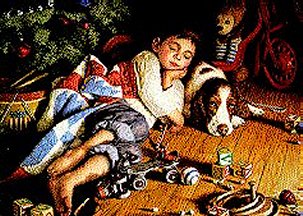
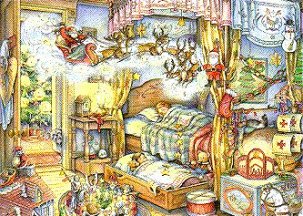
A
Brief History of Christmas and
Winter
Solstice Celebrations


A
Brief History of Christmas and
Winter
Solstice Celebrations
The history of Christmas dates back over 4000 years. Many of our Christmas traditions were celebrated centuries before the Christ child was born. The 12 days of Christmas, the bright fires the yule log, the giving of gifts, carnivals(parades) with floats, carolers who sing while going from house to house, the holiday feasts, and the church processions can all be traced back to the early Mesopotamians.Many of these traditions began with the Mesopotamian celebration of New Years. The Mesopotamians believed in many gods, and as their chief god - Marduk. Each year as winter arrived it was believed that Marduk would do battle with the monsters of chaos. To assist Marduk in his struggle the Mesopotamians held a festival for the New Year. This was Zagmuk, the New Year's festival that lasted for 12 days.
The Mesopotamian king would return to the temple of Marduk and swear his faithfulness to the god. The traditions called for the king to die at the end of the year and to return with Marduk to battle at his side.
To spare their king, the Mesopotamians used the idea of a "mock" king. A criminal was chosen and dressed in royal clothes. He was given all the respect and privileges of a real king. At the end of the celebration the "mock" king was stripped of the royal clothes and slain, sparing the life of the real king.
The Persians and the Babylonians celebrated a similar festival called the Sacaea. Part of that celebration included the exchanging of places, the slaves would become the masters and the masters were to obey.
Early Europeans believed in evil spirits, witches, ghosts and trolls. As the Winter Solstice approached, with its long cold nights and short days, many people feared the sun would not return. Special rituals and celebrations were held to welcome back the sun.
In Scandinavia during the winter months the sun would disappear for many days. After thirty-five days scouts would be sent to the mountain tops to look for the return of the sun. When the first light was seen the scouts would return with the good news. A great festival would be held, called the Yuletide, and a special feast would be served around a fire burning with the Yule log. Great bonfires would also be lit to celebrate the return of the sun. In some areas people would tie apples to branches of trees to remind themselves that spring and summer would return.
The ancient Greeks held a festival similar to that of the Zagmuk/Sacaea festivals to assist their god Kronos who would battle the god Zeus and his Titans.
The Romans celebrated their god Saturn. Their festival was called Saturnalia which began the middle of December and ended January 1st. With cries of "Jo Saturnalia!" the celebration would include masquerades in the streets, big festive meals, visiting friends, and the exchange of good-luck gifts called Strenae (lucky fruits). The Romans decked their halls with garlands of laurel and green trees lit with candles. Again the masters and slaves would exchange places.
"Jo Saturnalia!" was a fun and festive time for the Romans, but the Christians though it an abomination to honor the pagan god. The early Christians wanted to keep the birthday of their Christ child a solemn and religious holiday, not one of cheer and merriment as was the pagan Saturnalia.
But as Christianity spread they were alarmed by the continuing celebration of pagan customs and Saturnalia among their converts. At first the Church forbid this kind of celebration. But it was to no avail. Eventually it was decided that the celebration would be tamed and made into a celebration fit for the Christian Son of God.
Some legends claim that the Christian "Christmas" celebration was invented to compete against the pagan celebrations of December. The 25th was not only sacred to the Romans but also the Persians whose religion Mithraism was one of Christianity's main rivals at that time. The Church eventually was successful in taking the merriment, lights, and gifts from the Saturanilia festival and bringing them to the celebration of Christmas.
The exact day of the Christ child's birth has never been pinpointed. Traditions say that it has been celebrated since the year 98 AD. In 137 AD the Bishop of Rome ordered the birthday of the Christ Child celebrated as a solemn feast. In 350 AD another Bishop of Rome, Julius I, choose December 25th as the observance of Christmas.
The common abbreviation for Christmas to Xmas is derived from the Greek
alphabet. X is letter Chi, which is the first letter of Christ's name in
the Greek
alphabet.
Oliver Cromwell, in England banned Christmas Carols between 1649 and
1660. Cromwell thought that Christmas should be a very solemn day so he
banned carols and parties. The only celebration was by a sermon and a
prayer service.
In 1643, the British Parliament officially abolishes the celebration of
Christmas.
The Puritans in America tried to make Thanksgiving Day the most important
annual festival instead of Christmas.
Silent Night was written in 1818, by an Austrian priest Joseph Mohr. He
was
told the day before Christmas that the church organ was broken and would
not be prepared in time for Christmas Eve. He was saddened by this and
could not think of Christmas without music, so he wanted to write a carol
that
could be sung by choir to guitar music. He sat down and wrote three stanzas.
Later that night the people in the little Austrian Church sang "Stille
Nacht" for
the first time.
St Francis of Assisi introduced Christmas Carols to formal church services.
Telesphorus, the second Bishop of Rome (125-136 AD) declared that public
Church services should be held to celebrate "The Nativity of our Lord and
Saviour." In 320 AD, Pope Julius I and other religious leaders specified
25
December as the official date of the birth of Jesus Christ.
26 December was traditionally known as St Stephen's Day, but is more
commonly known as Boxing Day. This expression came about because
money was collected in alms-boxes placed in churches during the festive
season. This money was then distributed during to the poor and needy after
Christmas.
Melbourne, Australia has a sporting Boxing Day tradition. The Melbourne
Cricket Ground hosts a Cricket test match. Sometimes this attracts 90,
000
spectators. Cricket is Australia's premier Summer sport.
The first printed reference to Christmas trees appeared in Germany in 1531
In 1836, Alabama is the first state in the USA to declare Christmas a legal
holiday.
In 1843, the first Christmas card was printed in England for Sir Henry
Cole. He
was busy man who wanted to save time in his own Christmas letters, but
was
also interested in encouraging the expansion of the postal system. 1000
copies of the card were sold at one shilling each. It was not until the
1860s
that the production of cards accelerated, with cheaper printing methods.
Then
in 1870, the Post Office introduced a half penny stamp for sending cards.
In 1856, President Franklin Pierce decorates the first White House Christmas
tree.
In 1907, Oklahoma became the last USA state to declare Christmas a legal
holiday.
At midnight on Christmas Eve 1914 firing from the German trenches suddenly
stopped. A German brass band began playing Christmas carols. Early,
Christmas morning, the German soldiers came out of their trenches,
approaching the allied lines, calling "Merry Christmas". At first the allied
soldiers thought it was a trick, but they soon climbed out of their trenches
and
shook hands with the German soldiers. The truce lasted a few days, and
the
men exchanged presents of cigarettes and plum puddings, sang carols and
songs. They even played a game of Soccer.
In 1937, the first postage stamp to commemorate Christmas was issued in
Austria.
In 1974, the Australian city of Darwin is devastated late on Christmas
Eve and
in the early hours of the morning by Cyclone Tracy.
Spain and South America: The Three KingsIn 1834, Queen Victoria's husband, Prince Albert brought the first Christmas
tree to Windsor Castle for the Royal family.6 December is St Nicholas's Day - the first of the gift giving days, especially in
Holland and Belgium.Some priests in Australia advise you to say "Happy Christmas", not "Merry Christmas", because Merry has connotations of getting drunk - which brings its own problems. One should say "Happy" instead.
The actual gift givers are different in various countries:
Every year since 1947 the people in Oslo have given a Christmas tree to
the
city of Westminster. The gift is an expression of goodwill and gratitude
for
Britain's help to Norway in the 1939-1945 war.
The first American Christmas carol was written in 1649 by a minister named
John de Brebeur and is called "Jesus is Born".
Mexicans call the poinsettia "Flower of the Holy Night" - the Holy Night
is the
Mexican way of saying "Christmas Eve".
Tom Smith who owned a sweet shop in London was the originator of the
cracker. In the 1840s Tom found that people like sugar almonds, but while
he
was in France he discovered a variety of sweets wrapped up in a twist of
paper. These bonbons were popular, so Tom decided to copy them. When
Tom noticed that young men were buying them to give to their sweethearts
he
began to place "love mottoes" on small slips of paper inside the sweet
wrapping.
In 1846 Tom's thoughts turned towards Christmas - instead of sweets he
thought he would place toys and novelties inside the twisted wrapping.
He
experimented with this and the idea of producing a wrapping that could
be
pulled apart - just like the cracker as we know it today.
The word carol is derived from the old French word caroller which derives
from
the Latin choraula. This itself was derived from the Greek choraules.
Births on 25 December:
W C Field (1946)
Alice Cooper (1945)
Princess Alexandra (1936)
Paul Borget (1935)
Charles Spencer Chaplin (1889)
Deaths on 25 December:
Conrad Hilton (1979)
Humphrey Bogart (1957)
Dorothy Wordsworth (1855)
Sir Isaac Newton (1727)
The biggest selling Christmas single of all time is Bing Crosby's White
Christmas.
In Switzerland during the Reformation, al instrumental and choral music
was
banned from churches. In Germany, disapproval of carols resulted in some
being converted into hymns.
Tinsel on the Christmas Tree is attributed to a woman whose husband died.
She was left to bring up a large family of children herself. She was left
to do
everything working so hard and she was determined to make a happy time
for
them at Christmas. She prepared a Christmas Tree to surprise them on
Christmas Day. Unfortunately spiders visited the tree, and crawled from
branch to branch, making webs all over it. The Christ Child saw the tree
and
knew she would be devastated to find this on Christmas morning. He changed
the spiders' webs to shining silver.
The first church the Dutch built in New York City was named in St Nicholas'
honour -St Nicholas Church.
Many Christmas customs are carryovers from pre-Christian celebrations.
Hanging gifts on trees is supposed to stem from tree worship of the Druids,
and the belief that the tree was the giver of all good things. The Druids
are
also partly responsible for the use of mistletoe at Christmastime. They
regarded the mistletoe as sacred, made certain that it never touched the
ground, and dedicated it to the Goddess of Love, which explains the kissing
that goes on under it. Originally, when a boy kissed a girl, he plucked
a berry
from the cluster and presented it to her. When the berries were gone, so
were
the kisses.
In Christmas tree decorations, angels are usually portrayed as wimpy blondes
in girl's blouses and sandals. In the Bible, however, angels are muscular
bullies who frequently goad humans into fistfights. Life isn't all harps
and
heavenly choirs for angels; there's a strict career structure. The only
angels
mentioned by name in the Bible are archangels, the eighth-ranking order
of
angels.
Visitors to Bethlehem rarely exceed a few thousand at Christmas. In 1995,
there were rowdy celebrations of the first Christmas in a Palestinian-controlled
Bethlehem. The Christmas Eve service televised on 25 December is
celebrated not in the Church of the Nativity, which stands over the place
where Jesus was said to have been born, but in the nearby Franciscan
Church of St. Catherine.
The largest functional Christmas cracker was 45.72 metres long and 3.04
metres in diameter. It was made by Australian international rugby player
Ray
Price in Markson Sparks of New South Wales, Australia and was pulled in
the
car park of the Westfield Shopping Town in Chatswood, Sydney, Australia
on
9 November 1991.
A goose was customary Christmas fare until Henry VIII took it upon himself
to
tuck into a turkey. Mince pies were once shaped like mangers and are
thought to date back to the sweetmeats formerly presented to the Vatican
on
Christmas Eve.
The freedom-fighter and religious activist thought to have been born between
6
BC and 30 AD, by the name of Jesus Christ from the Greek christos, "the
anointed one". He was born in a stable in Bethlehem. He started out as
a
carpenter, but became a missionary following his baptism by a cousin, John.
After proclaiming himself the Messiah, Jesus was betrayed by a disciple
and
crucified. He is later said to have risen from the dead.
If you're wondering why men may have not flocked to kiss you under the
mistletoe, the answer may be that it was said that it will only work if
the
person you are kissing is a virgin. On the sixth day of the new moon, a
Druid
priest used to cut mistletoe from an oak tree with a sacred sickle. A passing
virgin was called upon to catch the falling plant, which was not allowed
to
touch the ground.
The first commercial Christmas card, produced in 1846, featured a drawing
of
family members happily toasting each other with glasses of wine - a
shockingly decadent portrait that was immediately condemned by
temperance advocates. In New South Wales, Australia, the average daily
mailbag of six to seven million items of mail can triple over Christmas.
The
heaviest day ever was on 23 December 1997, when a record 23 million items
were delivered in this state in Australia.
Santa's Reindeers are Dasher, Dancer, Prancer, Vixen, Comet, Cupid,
Donner and Blitzen.
Saint Boniface is said to have substituted a fir tree for the pagan oak
in the
eighth century as a symbol of faith. Martin Luther fostered the Christmas
tree
cult by using a candlelit tree as a symbol of Christ's heavenly home, while
trees decorated with candles, fruit and paper flowers were introduced into
Britain soon after Queen Victoria's marriage.
The Celts used to bring a large log indoors as a tribute to the sun god.
In
Cornwall, revellers would chalk a symbol of a man on the log in a cheery
reference to the human sacrifices who used to be thrown on the bonfire.
Ancient Roman observances of the Natalis solis invicti and the Saturnalia
occurred in December and involved much feasting, singing, parades and other
forms of celebrating. Not to be outdone, when the Church adopted Christmas
it introduced a major Christian celebration and feasting became a part
of the
festivities. As the centuries wore on, depending upon the country, a
Christmas goose, turkey or other animal was adopted as the main course
in
the Christmas feast.
The Christmas tree was first decorated with lights in the 16th century.
It is
believed that Martin Luther, the Protestant reformer, was the first to
add
lighted candles to the tree. He was so taken with the Christmas night sky
that
he wished to bring "the lights of the stars" into the home of his family.
From
this, decorating the tree with ornaments, messages and notes, and small
gifts
emerged in later centuries leading to our customs today.
Hanging the Christmas stocking on the hearth on Christmas Eve in the hope
that it will be filled with presents the next morning is a custom that
goes back
about 400 years. It derived from the custom in Holland of children placing
wooden shoes next to the hearth the night before the arrival of St. Nicholas.
The children would fill their shoes with straw and food for St Nicholas's
for the
donkey that carried the gifts. In exchange he would leave them a small
gift
such as small cakes, fruits and other gifts. Stockings were substituted
for the
shoes in Britain, most of Europe and in North America.
A wreath with holly, red berries and other decorations began from at least
the
17th century. Holly, with its sharply pointed leaves, symbolised the thorns
in
Christ's crown-of-thorns. Red berries symbolised the drops of Christ's
blood. A
wreath at Christmas signified a home that celebrated to birth of Christ.
On Christmas morning since medieval times, church bells have been rung
to
announce to the world the coming of the saviour. It was customary from
the
18th century to wear clothes and carry a small bell to signify the birth
of
Christ. The ringing of the bells was to signify the importance of the His
Birth.
Santa Claus is perhaps the most remarkable of all the figures associated with Christmas. To us, Santa has always been an essential part of the Christmas celebration, but the modern image of Santa didn't develop until well into the 19th century. Moreover, he didn't spring to life fully-formed as a literary creation or a commercial invention (as did his famous reindeer, Rudolph). Santa Claus was an evolutionary creation, brought about by the fusion of two religious personages (St. Nicholas and Christkindlein, the Christ child) to become a fixed image which is now the paramount symbol of the secular Christmas celebration.In 1804, the New York Historical Society was founded with Nicholas as its patron saint, its members reviving the Dutch tradition of St. Nicholas as a gift-bringer. In 1809, Washington Irving published his satirical A History of New York, by one "Diedrich Knickerbocker," a work that poked fun at New York's Dutch past (St. Nicholas included). When Irving became a member of the Society the following year, the annual St. Nicholas Day dinner festivities included a woodcut of the traditional Nicholas figure (tall, with long robes) accompanied by a Dutch rhyme about "Sancte Claus" (in Dutch, "Sinterklaas"). Irving revised his History of New York in 1812, adding details about Nicholas' "riding over the tops of the trees, in that selfsame waggon wherein he brings his yearly presents to children." In 1821, a New York printer named William Gilley issued a poem about a "Santeclaus" who dressed all in fur and drove a sleigh pulled by one reindeer. Gilley's "Sante," however, was very short.
On Christmas Eve of 1822, another New Yorker, Clement Clarke Moore, wrote down and read to his children a series of verses; his poem was published a year later as "An Account of a Visit from St. Nicholas" (more commonly known today by its opening line, "'Twas the night before Christmas . . ."). Moore gave St. Nick eight reindeer (and named them all), and he devised the now-familiar entrance by chimney. Moore's Nicholas was still a small figure, however -- the poem describes a "miniature sleigh" with a "little old driver." Meanwhile, in parts of Europe such as Germany, Nicholas the gift-giver had been superseded by a representation of the infant Jesus (the Christ child, or "Christkindlein"). The Christkindlein accompanied Nicholas-like figures with other names (such as "Père Nöel" in France), or he travelled with a dwarf-like helper (known in some places as "Pelznickel," or Nicholas with furs). Belsnickle (as Pelznickel was known in the German-American dialect of Pennsylvania) was represented by adults who dressed in furry disguises (including false whiskers), visited while children were still awake, and put on a scary performance. Gifts found by children the next morning were credited to Christkindlein, who had come while everyone was asleep. Over time, the non-visible Christkindlein (whose name mutated into "Kriss Kringle") was overshadowed by the visible Belsnickle, and both of them became confused with St. Nicholas and the emerging figure of Santa Claus.
The modern Santa Claus derived from these two images: St. Nicholas the elf-like gift bringer described by Moore, and a friendlier "Kriss Kringle" amalgam of the Christkindlein and Pelznickel figures. The man-sized version of Santa became the dominant image around 1841, when a Philadelphia merchant named J.W. Parkinson hired a man to dress in "Criscringle" clothing and climb the chimney outside his shop. In 1863, a caricaturist for Harper's Weekly named Thomas Nast began developing his own image of Santa. Nast gave his figure a "flowing set of whiskers" and dressed him "all in fur, from his head to his foot." Nast's 1866 montage entitled "Santa Claus and His Works" established Santa as a maker of toys; an 1869 book of the same name collected new Nast drawings with a poem by George P. Webster that identified the North Pole as Santa's home. Although Nast never settled on one size for his Santa figures (they ranged from elf-like to man-sized), his 1881 "Merry Old Santa Claus" drawing is quite close to the modern-day image.
The Santa Claus figure, although not yet standardized, was ubiquitous by the late 19th century. Santa was portrayed as both large and small; he was usually round but sometimes of normal or slight build; and he dressed in furs (like Belsnickle) or cloth suits of red, blue, green, or purple. A Boston printer named Louis Prang introduced the English custom of Christmas cards to America, and in 1885 he issued a card featuring a red-suited Santa. The chubby Santa with a red suit (like an "overweight superhero") began to replace the fur-dressed Belsnickle image and the multicolored Santas.
At the beginning of the 1930s, the burgeoning Coca-Cola company was still looking for ways to increase sales of their product during winter, then a slow time of year for the soft drink market. They turned to a talented commercial illustrator named Haddon Sundblom, who created a series of memorable drawings that associated the figure of a larger than life, red-and-white garbed Santa Claus with Coca-Cola. Coke's annual advertisements -- featuring Sundblom-drawn Santas holding bottles of Coca-Cola, drinking Coca-Cola, receiving Coca-Cola as gifts, and especially enjoying Coca-Cola -- became a perennial Christmastime feature which helped spur Coca-Cola sales throughout the winter (and produced the bonus effect of appealing quite strongly to children, an important segment of the soft drink market). The success of this advertising campaign has helped fuel the legend that Coca-Cola actually invented the image of the modern Santa Claus, decking him out in a red-and-white suit to promote the company colors -- or that at the very least, Coca-Cola chose to promote the red-and-white version of Santa Claus over a variety of competing Santa figures in order to establish it as the accepted image of Santa Claus.
This legend is not true. Although some versions of the Santa Claus figure still had him attired in various colors of outfits past the beginning of the 20th century, the jolly, ruddy, sack-carrying Santa with a red suit and flowing white whiskers had become the standard image of Santa Claus by the 1920s, several years before Sundlom drew his first Santa illustration for Coca-Cola. As The New York Times reported on 27 November 1927:
A standardized Santa Claus appears to New York children. Height, weight, stature are almost exactly standardized, as are the red garments, the hood and the white whiskers. The pack full of toys, ruddy cheeks and nose, bushy eyebrows and a jolly, paunchy effect are also inevitable parts of the requisite make-up.
It's simply mind-boggling that at the beginning the 21st century, historians are still egregiously perpetuating inaccurate information like the following:
So complete was the colonization of Christmas that Coke's Santa had elbowed aside all comers by the 1940s. He was the Santa of the 1947 movie Miracle on 34th Street just as he is the Santa of the recent film The Santa Clause. He is the Santa on Hallmark cards, he is the Santa riding the Norelco shaver each Christmas season, he is the department-store Santa, and he is even the Salvation Army Santa! [Twitchell, 2000]As we just pointed out above, the modern Santa had "elbowed aside all comers" long before the 1940s, and well before Coca-Cola co-opted him as their wintertime advertising symbol. And we're at a loss to understand how anyone could have recognized the Santa of Miracle on 34th Street as the red-and-white Coca-Cola Santa, since the film was made in black and white!All this isn't to say that Coca-Cola didn't have anything to do with cementing that image of Santa Claus in the public consciousness. The Santa image may have been standardized before Coca-Cola adopted it for their advertisements, but Coca-Cola had a great deal to do with establishing Santa Claus as a ubiquitous Christmas figure in America at a time when the holiday was still making the transition from a religious observance to a largely secular and highly commercial celebration. In an era before color television (or commercial television of any kind), color films, and the widespread use of color in newspapers, it was Coca-Cola's magazine advertisements, billboards, and point-of-sale store displays that exposed nearly everyone in America to the modern Santa Claus image. Coca-Cola certainly helped make Santa Claus one of the most popular men in America, but they didn't invent him.
Ward's, not Santa, created Rudolph When Montgomery Ward announced that it was going out of business, a fascinating snippet of the company's past got scant attention.
By GREG HASSELLOne of the department store's most endearing and enduring legacies is Rudolph the Red-Nosed Reindeer, a Christmas staple that began as nothing more than a marketing ploy.
Back in the 1930s, the Santas working in Montgomery Ward stores gave away coloring books to kids visiting at Christmas time. Eager to save on promotional costs, the company decided to create and publish its own little storybook.
It gave the job to Robert L. May, an in-house copywriter fond of making up stories. May drew on his experience as a shy and diminutive youngster to create the story of a little reindeer who was ostracized because of a physical abnormality.
May's 4-year-old daughter gave the tale two thumbs up, but company executives were less receptive. They especially didn't like the character's name -- Rollo. A second suggestion -- Reginald -- was shot down as well.
May changed the name to Rudolph and got a friend to make playful sketches of reindeer at Chicago's Lincoln Park Zoo. That sold the suits on the story, and the first copies of Rudolph the Red-Nosed Reindeer went into children's hands in 1939.
Rudolph became a bona fide celebrity after Johnny Marks, May's brother-in-law, wrote a song based on the story. Singing cowboy Gene Autry cut the record and made the song into a huge hit in 1949.
So the next time you are thinking about what a miserable failure modern-day Montgomery Ward is, consider its colorful past. By the way, the company demonstrated that it could not only be creative, but in the true tradition of Christmas, compassionate.
May's wife was terminally ill when he created Rudolph, and medical bills left him deeply in debt. He persuaded the company to give him the copyright to the story he had created. That gift allowed him to live comfortably through his retirement from Ward's in 1971 and his death five years later.
|
the Red-Nosed Reindeer by Johnny Marks 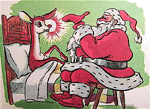
You know Dasher and Dancer, and Prancer and Vixen, Comet and Cupid, and Donner and Blitzen, But do you recall The most famous reindeer of all? |
Had a very shiny nose, And if you ever saw it, You could even say it glows. All of the other reindeer Used to laugh and call him names; They never let poor Rudolph Join in any reindeer games. Then one foggy Christmas Eve,
|
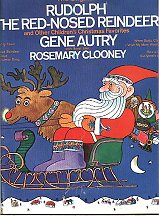
A Russian couple were walking down the street in Moscow one night, when the man felt a drop hit his nose.
"I think it's raining", he said to his wife.
"No, that felt more like snow to me", she replied.
"No, I'm sure it was just rain" he said.
Well, as these things go, they were about to have a major argument about whether it was raining or snowing.
Just then they saw a Communist Party official walking toward them.
"Let's not fight about it", the man said, "let's ask Comrade Rudolph whether it's officially raining or snowing".
As the official approached, the man said, "Tell us, Comrade Rudolph, is it officially raining or snowing?"
"It's raining, of course", he replied, and walked on.
But the woman insisted: "I know that felt like snow!", to which the man quietly replied:"Rudolph the Red knows rain, dear" 
A Struggling Dickens wrote “A Christmas Carol”
to Enlighten the World and Make Fast Money
www.thevintagenews.com/2017/12/22/a-christmas-carol/
CHAPTER PICTURES FROM DICKENS' A CHRISTMAS CAROL
by John Leech 1897





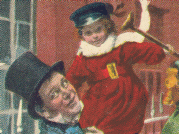
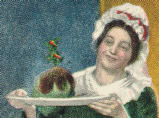
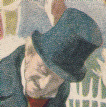
STORIES AND POEMS
A
Christmas Carol by Charles Dickens
A
Christmas Carol (as condensed by Dickens for his readings)
A
Christmas Carol (with 1897 chapter headings by John Leech)
The Life and Adventures
of Santa Claus by L. Frank Baum
Reference Sites
The History of Christmas
Christmas Trivia
Origins of Santa Claus
Ward's, not Santa, created Rudolph
![]()
THE HILLMAN CHRISTMAS AND WINTER
SOLSTICE SITES
BACK
TO THE HILLMAN NOSTALGIA CHRISTMAS
Bill Hillman
To the www.HillmanWeb.com
Music Bio Site